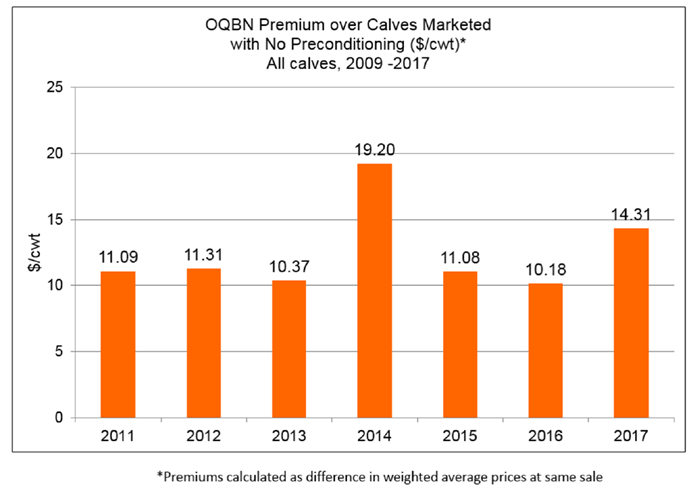
I wrote about the OQBN program and the associated premiums a few weeks ago but Scott Clawson, OSU Extension Area Ag Economist, more eloquently discusses these potential premiums, and premiums associated with seasonal price changes, in the following comments.
The time of year is upon us to begin planning how we will market our spring born calves. As we fix our eyes on the market’s movements and our checkbook balance, we start to figure out a strategy. As with every plan, we need to make sure we are accurate, conservative, and as thorough as possible. The easiest option is to sell directly off the cow, an option that you can see in every livestock auction in the fall. The discount that follows from this strategy is usually significant. The other option is to wean, “straighten out”, and market those cattle at least 45 days later. Backgrounding premiums and seasonal price changes are the two main positive price movements take place in that 45 plus days after weaning.
Backgrounding premiums exist and are being displayed in many areas as most local livestock auctions facilitate their own programs. In the graphic, we see the annual premiums from the Oklahoma Quality Beef Net-work (OQBN) sales. We see variation from year to year, but it’s obvious that the practice has value. Adding to this, there is variation amongst weights. Within a single year a 400# calf may yield a higher dollar per hundredweight premium for preconditioning than does a 600# calf. This stands to reason as the 400# bawling calf is more high risk than the heavier calf. The importance of this number is that it is a comparison to calves selling the same day. This is valuable to demonstrate the premium for that management practice, but it does not illustrate the seasonal price gains that take place over the typical preconditioning period.

Beefbasis.com is a great way to price forecast for the fall. Using this tool, we estimate that a 500# medium/large muscle score #1 weaned calf in mid-October would be $163.53/cwt. We make a modest gain calculation of 1.5#/day over a 60-day backgrounding program. This leaves us in mid-December with a 590# calf with an estimated value of $157.67/cwt. The second part of this equation is the additional value that we anticipate for the VAC-45 management practices we took on. Looking at the data from 2017 and previous years, we could use a conservative $9/cwt addition to our mid-December calf price ($157.67 + $9 = $166.67/cwt) for participating in OQBN. It is worth noting that the value of this 500# calf at this point (Mid-December) is $169.67. This compared with the estimated value of the same calf quality and weight in October displays the seasonal price improvement that we see on average.
Collectively, we could sell a bawling calf in mid-October that weighs 500# for $817.65. The other option is to hold off marketing for 60 days and participate in a VAC-45 program. This gives us the opportunity to capture a seasonal price improvement as well as a VAC-45 premium. The 590# calf in mid-December has an estimated value of $983.35. The difference is $165.70/hd, but this is not profit as no costs have been deducted. But it does provide a starting point to begin our budget. Individual costs per producer will be variable based on set up and resources. Also, each producer will assign a different value for labor, management, and death loss.
At the end of the day, there is risk involved in any ranch decision. Death loss, poor gains, price, and marketing risk are all lurking in the background. We can mitigate price risk by using price protection tools. However, leaning on the history of seasonal price moves and VAC-45 premiums, we have a chance to manufacture some extra profit.
Find out what’s happening on the Oklahoma Cooperative Extension Calendar at https://calendar.okstate.edu/oces/#/?i=2
Follow me on Facebook @ https://www.facebook.com/leland.mcdaniel
Oklahoma State University, in compliance with Title VI and VII of the Civil Rights Act of 1964, Executive Order 11246 as amended, and Title IX of the Education Amendments of 1972 (Higher Education Act), the Americans with Disabilities Act of 1990, and other federal and state laws and regulations, does not discriminate on the basis of race, color, national origin, genetic information, sex, age, sexual orientation, gender identity, religion, disability, or status as a veteran, in any of its policies, practices or procedures. This provision includes, but is not limited to admissions, employment, financial aid, and educational services. The Director of Equal Opportunity, 408 Whitehurst, OSU, Stillwater, OK 74078-1035; Phone 405-744-5371; email: eeo@okstate.eduhas been designated to handle inquiries regarding non-discrimination policies. Any person who believes that discriminatory practices have been engaged in based on gender may discuss his or her concerns and file informal or formal complaints of possible violations of Title IX with OSU’s Title IX Coordinator 405-744-9154.